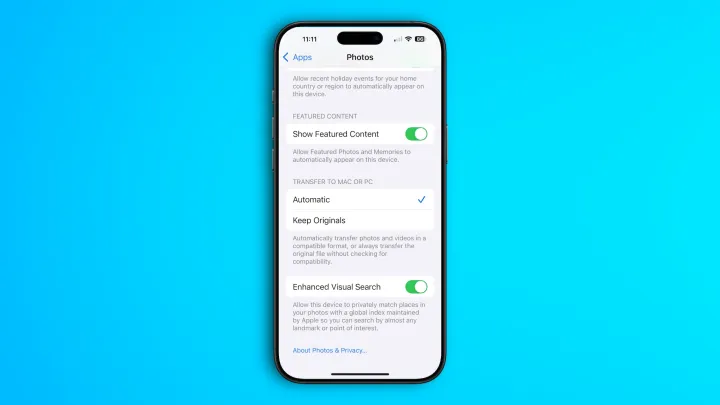A relatively new Apple feature makes visual search much more powerful. It also raises privacy concerns, according to developer Jeff Johnson.
Starting with iOS 18 and macOS 15, Apple introduced Enhanced Visual Search (EVS) in the Photos app. This new technology builds on the company’s existing Visual Look Up (VLU) feature, enabling your device to identify landmarks and points of interest in your photos. In doing so, it enhances visual search functionality, allowing you to leave prompts like “Show me photos from the beach” or “Show me photos of sunsets.”
VLU, launched with iOS 15, requires sending Apple “limited” data to its servers. After finding two Apple documents about EVS, Johnson believes the new feature requires sending even more information to the company.
And on that point, the developer isn’t happy, stating: “Of course, this user never requested that my on-device experiences be ‘enriched’ by phoning home to Cupertino [California site of Apple’s headquarters]. This choice was made by Apple, silently, without my consent.”
Johnson points out that the new feature and its requirements have “mostly gone unmentioned” by the “Apple news media.” Additionally, it “has also mostly gone unmentioned by Apple itself.”
Is this correct? I don’t believe so.
Much has been written about the new Photos app features in iOS 18, including its improved search. Digital Trends, for example, mentioned it on our iOS 18 overview page, and at least one of our writers complained about some of the Photos app changes that came with the iOS 18 update.
For its part, Apple, as Johnson noted, mentions EVS in terms of privacy in at least two online documents. One is a “Photos & Privacy” document designed for end users, while the other is more research-related.
The first reads:
“Enhanced Visual Search in Photos allows you to search for photos using landmarks or points of interest. Your device privately matches places in your photos to a global index Apple maintains on our servers. We apply homomorphic encryption and differential privacy, and use an OHTTP relay that hides IP address. This prevents Apple from learning about the information in your photos.”
Don’t these points prove that EVS was mentioned by both the media and Apple?

Beyond this, Apple makes removing the feature on your iPhone/iPad or Mac relatively pain-free.
On iPhone, go to Settings > Apps > Photos and scroll to the bottom, where you will find a toggle for EVS. Toggle this off to stop using the feature. On Mac, open Photos and go to Settings > General. From there, scroll down and toggle off EVS.
Apple also offers a message on both devices: “Allow this device to privately match places in your photos with a global index maintained by Apple so you can search by almost any landmark or point of interest.”
I understand Johnson’s concerns about EVS, particularly his worry that the feature is enabled by default. However, I can’t imagine that this would upset most users. The content provided to Apple for the feature is encrypted. Additionally, as Apple points out, the upload process is designed to protect the privacy of your photos, ensuring that the company does not access your information.
